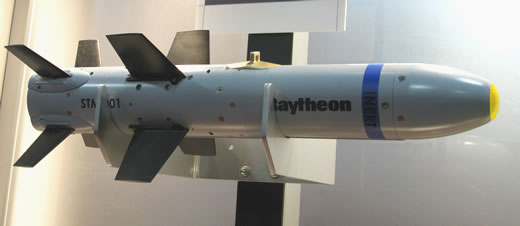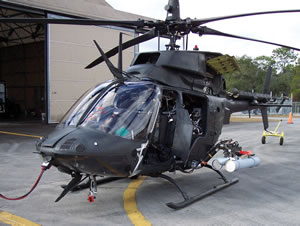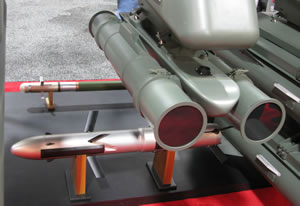The Griffin developed by Raytheon was publicly displayed at AUSA 2010. The missile, described by the manufacturer as a ‘Real Time Attack System’, weighs 33 pounds, about a third of the Hellfire’s weight, yet is capable of hitting targets at a range of 12.5 km when launched from an aerial vehicle. ” We originally developed the Griffin missile with our own funding, using components from other proven systems, and it is now integrated aboard the AFSOC C-130W Dragon Spear.” said Harry Schulte, vice president of Raytheon Missile System’s Air Warfare Systems’ product line.

Two versions of the missile are available. The A round is an aft-eject missile, designed for integration on aircraft such as the Dragon Spear; the B round is a forward-firing missile that can fire from unmanned platforms, helicopters and ground launchers. Griffin has been demonstrated firing from launchers attached to the U.S. Army Remote Weapon Station and Multi-round Wedge launcher. The Wedge can be mounted on vehicles or used as a ground launcher, offering short-range precision fire and combat outpost protection.



When employed from a ground launcher Griffin can hit targets at a minimal ranges of 1000 m’ up to 5.5 km. The missile was designed for wheight-critical applications, including arming unmanned systems, light scout helicopters or support of dismounted, light infantry operations.
Griffin was designed to maintain commonality with existing launchers, such as the Hellfire Common Launcher Tube, by using a pattented ‘Smart Launcher’ that attaches the missile to existing weapon stations facilitating communications across the platform’s interface. This integration method enables simple adaptation to multiple manned and unmanned platforms.
This small missile is expected to be a weapon of choice to be employed by UAVs, light helicopters as well as large C-130 platforms, providing a localized, yet effective impact on the target, while minimizing collateral damage to non combatants and nearby troops. The Griffin uses semi-active laser guidance, integrated with GPS/INS for backup, enabling non-line-of-sight engagement. The 13 pounds warhead is a blast-fragmenting type, optimized for soft target lethality rather than armor penetration. The fuse can be set to one of three modes – point detonate, height of burst or delay.


‘Griffin enables the user to shape an attack through a simple, easy to use graphic user interface’, describes Raytheon, ‘The user can select to guide the weapon precisely to the target using GPS coordinates, inertial navigation or laser designation. To maximize kinetic effects and lethality the system also enables the conduct of Multiple Round Simultaneous Impact (MRSI) target engagement, increasing the effectiveness of the attack. The missile is also designed to attack moving targets and has demonstrated this capability in several test firings.
The Small Tactical Munition (Pyros) is another miniature weapon in development at Raytheon. This small and light weapon, (weight 13.5 pounds), more than half its weight the warhead (7 pound). This weapon is a precision guided gravity bomb with INS/GPS and Semi-Active Laser guidance, which has proven extremely successful during testing.
















